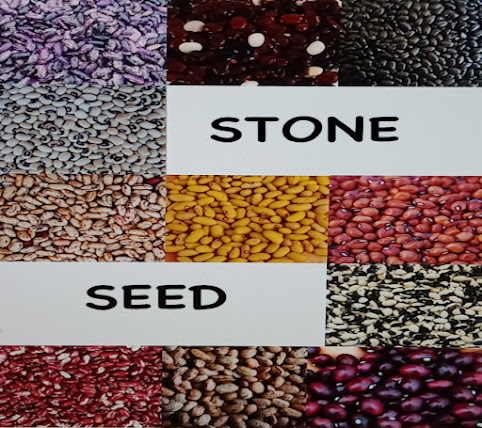Well now, what happened with garden season 2023?
I did not start a single plant from seed. I had over-wintered Yacon corms and put those plants out very late and with little preparation of the area. I appreciate that some of the corms planted grew into plants that produced a small crop of tubers, that I, after seasoning for a few weeks, added into a few batches of kimchi. It was an okay addition. I am still acquainting myself with the taste of Yacon, so less would be best in my kimchi. Perhaps seasoned Yacon chips will be more to my liking.
I thought that getting the Yacon planted would be all of the gardening I would do, until I discovered one bean plant growing at the edge of where I had planted a test plot of beans in 2023. I did not know what bean would develop because the test plot had been an Alpine grex. As the seed pods began to ripen, I opened up the first fully ripened and dried pod to find what appeared to be a Sacaton Brown Tepary or possibly a hybrid from the Joseph Lofthouse Tepary grex I’d grown as one group in 2022. A great resource on Tepary is Joseph Lofthouses Landrace Seeds and the traditional resources of Native Seeds Search. To learn more about landraces, visit World Atlas.
This is a first for me. A volunteer legume! This Tepary opens up a lot of questions. I find at first it very mysterious since the Tepary is a heritage food that comes out of desert lands. Then I consider how cold desert temperatures may sometimes get. To this I added the fact of a number of inches of straw that acted as an insulation. What a gift! The oldest historical reference to tepary goes back to about 2500 years ago. It is an important food to the Tohono O’odham as a vital part of a healthy traditional foods diet because it is high in fiber and low on the glycemic levels. So glad that I dropped a pod and one seed lived and grew into a plant after a cold winter. I gathered over a quarter cup of seeds from that one plant! I have shared some of the seeds with others.
I continued with my third year of exploring Morning Glory flower dyeing, and when green persimmon season arrived, I added in exploring how to dye with the Indiana green persimmon. My blog about it is from a dyers perspective - Persimmon Astringent Dye.
The Peruvian Zinnia seeded itself for the second year, as did one of the red zinnias and the Cockscomb seeded its self to produce new plants!
This year, I have planted out the Yacon, seeded some Sokoyoto Spinach and intend planting some tepary grex and other beans and southern pea. Mid April and we have had some temperatures into the high seventies and down into the thirties!
I am undecided on what will be my best Memorial Bean choices for relatives. Memorial Beans or Other seeds designated as a memorial to deceased family and friends. The seeds can be shared out as their numbers increase to other family members who would like to grow the Memorial Beans. I have decided that a bean, or other seed can be appreciated as a memorial seed by all who want to adopt it.
This year, I sought out a rhubarb start. Fortunately, a friend gave me a tiny baby. At one point I thought that I had killed it, but am pleased to see that it lives! I acquired a few new beans, among them is Turkey Craw and Potawatomi; and flower seeds for dyeing, Indigo (to explore fresh leaf dyeing) and Dyers Correopsis. I am also planting what I hope will become a perennial Kale Grex; Emerald Pumpkin (a naked seeded pumpkin whose seeds are sold as pepita (Styrian or oilseed pumpkins) and I am awaiting germination of my Pigeon Peas.
I will continue to print and dye fabrics with Morning Glory flowers (just now germinating in the wild) and then onto green persimmons. I would be fine not having lots of stilt grass to dye with.
Stay curious and grow what you can of something you love, save what you can. I am currently rereading The Secret Life of Plants. It had been many decades. Seeds and Plants are awesome!
Good season to you and great harvest to you!
Patricia



